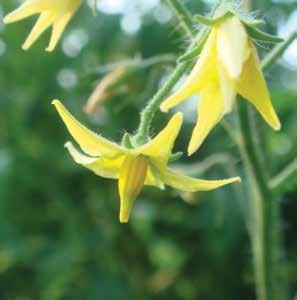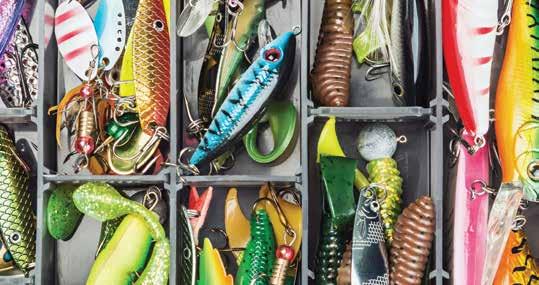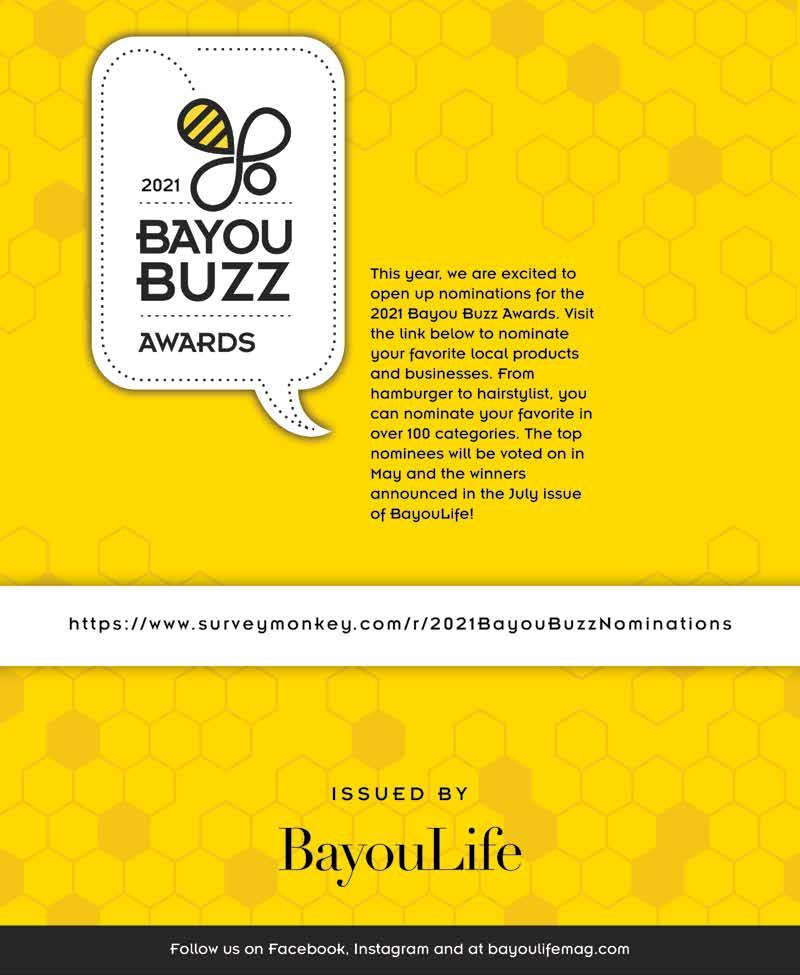
26 minute read
SCAVENGER HUNT
Scavenger HuntParticipate in this scavenger hunt throughout the Twin Cities. Follow the clues and discover Monroe - West Monroe outside the lines.
Complete this adventure, post your pics, and tag #BayouLifeMag and #DiscoverMWM to be entered to win a destination staycation prize package with attraction tickets, restaurant gift cards and more! To be entered to win, you must visit all nine locations. Contest ends May 31, 2021.
This is a hard one but perhaps you’ll know This is the oldest building in downtown Monroe. Once a law office, now home to Arrow Public Art This location will be your start.

Next is a place that’s been in the news It’s packed with flamingos and kangaroos This treasure is often overlooked But once you go, you’ll definitely be hooked.
What’s big and fun and purple all over It’s a place to play in a firehouse and maybe red rover Haven’t caught on to this clue yet Stay away from the giant bubbles or you might get wet.
Find this sculpture where warhawks fly It’s a reptile and by the bayou he lies Maroon and gold is his mosaic shell Take a picture and then wish it farewell.

Find this bomber in the field The name Floy’s Hope will be revealed It’s a bird that once roamed the sky One that General Chennault might fly.
This location’s name is part of a popular duo To find it you’ll have to travel to West Monroe In the front, you’ll find a four-legged animal It’s a bronze sculpture of a hoofed mammal. A trip to this place is sure to bring smiles It has playgrounds galore, and you can hike for miles You’ll see animals there, even ones that bark This is one of our most treasured parks.


You’ll find this place at the end of the Alley Edmund Williamson created this floral valley It’s worth the drive to take spring pics Adore the art and get a shopping fix.
Back across the river we go In a place where the soda fountains flow The museum and gardens are one-of-a-kind A Bible museum is among the things you’ll find.

CROWN JEWEL OF THE VEGETABLE GARDEN
LSU AG CENTER
Happy spring! For gardeners in the ArkLaMiss, April is the month for planting that crown jewel of the vegetable garden: the tomato! So, let’s really dig in this time and examine successful tomato growing.
Hopefully, you will have purchased your plants from the Northeast Louisiana Master Gardeners Association this year. Nineteen varieties are up for grabs, and each has its purpose. When looking at variety selection, ask yourself, “What’s my goal?” If sauces are the end products, then go with ‘Roma’ or ‘San Marzano.’ If a crisp summer salad is what you’re after, a variety like ‘Lime Green Salad,’ ‘Sweet Million,’ ‘Sun Gold,’ ‘Chocolate Cherry,’ or my personal favorite, the weedy ‘Matt’s Wild Cherry’ will do nicely. If a big ole ‘mater sammich is the prize, go with a larger variety like ‘Better Boy,’ ‘Classic Beefsteak,’ or an heirloom variety like ‘Cherokee Purple.’ Select other varieties recommended for the ArkLaMiss. In addition to those varieties previously mentioned, the LSU AgCenter recommends the following:
SPRING CROP INDETERMINATE
• Big Beef • Champion • Creole • Jet Star
SPRING CROP DETERMINATE
• Amelia • Bella Rosa • Celebrity • Mountain Fresh
SUMMER AND FALL CROP (HEAT SET)
• Florida 91 • Phoenix • Sun Leaper • Solar Set • Sunmaster

Transplants started from seeds in February and should be ready to set out in the garden this month. Some of you may grow tomatoes in containers. Determinate varieties are best for that because of the limited space the root systems have. When possible, grow tomatoes directly in the ground so roots have plenty of space.
Tomatoes are heavy feeders, so a pre-plant fertilizer application of 0.5 lbs. of either 8-2424 or 13-13-13 per 10 ft. row can be worked into the soil ahead of planting. Soil that gets full sun, has good internal drainage, and is supplemented with generous amounts of organic matter is prime tomato habitat. Being vines, indeterminate tomato plants will form adventitious roots as evidenced by tiny white bumps that form at nodes along the stem. For this reason, dig planting holes two to three times wider than the root ball on the transplant and set plants deep in the planting hole to guarantee a healthy, expansive root system which will increase the likelihood of a healthy, productive plant. If transplants are leggy, dig a trench four to six inches deep, pinch the first several pairs of leaves off, and lie the plant in the trench bending the last several inches of the plant’s top upward, and backfill around the plant with soil. Before placing the plant, put a couple handfuls of compost in the bottom of the hole or trench, and mix in a handful of pelletized gypsum (calcium sulfate). Adding gypsum to the planting hole is one way to stave off a condition called blossom end rot (BER), which occurs when the bloom end of the tomato turns black and mushy. BER is caused by a calcium deficiency where either the soil has calcium and the plant is unable to take it up, or, most commonly, the soil is deficient in calcium and there is little to none for the plant to take up. Adding calcium sulfate is a great way to add calcium to soil that needs it without raising the soil’s pH. Another way to add calcium without liming is to side dress with calcium nitrate every three weeks when the third cluster of fruit sets. Just a couple tablespoons per plant, worked into the soil and watered in, will do fine. A soil test performed during winter will tell you whether supplemental calcium is necessary or not. Don’t forget to mulch! A layer of mulch between the soil’s surface and the first pair or two of leaves can go a long way in preventing soil-borne pathogens from being splashed up onto the foliage when it rains. An organic mulch like hay, wheat straw, dried leaves or even lawn clippings provided the lawn hasn’t been treated with broadleaf herbicides. These materials will break down throughout the season and can be either turned into the soil

^ Remember, tomato flowers are self-pollinating. Help pollinate your tomato flowers by gently flicking the flowers with a finger.
VARIETY OF TOMATOES

as additional organic matter or be relegated to the compost pile when tomato season is over. Plastic mulches also work well but may be more of a hassle for the typical home gardener. Mulches also help soil retain moisture and help regulate soil temperature.
To stake or not to stake? ‘Tis the question. Botanically, tomato plants are vines and are perfectly happy either sprawling along the ground or being staked up. If allowed to sprawl, put down a mulch layer of straw, hay, etc., so fruit avoid direct contact with the ground. I grew the best crop of ‘Cherokee Purples’ ever several years ago when I simply let the vines run on the ground on a layer of straw. If space in your garden is premium, stake tomato plants up vertically on something like a t-post, piece of rebar, a traditional wooden stake, or a length of cured bamboo. A lot of gardeners like to use tomato cages, and these are easily fashioned out of 2 X 4 wire or concrete wire. If using stakes, place them in the ground prior to planting. Driving a stake through the ground next to an established plant risks damaging the root system. If using cages, get them situated around the plants before the plants get too large.
Remember, tomato flowers are self-pollinating. Insects are nice, but not required for plants to set fruit. Flower drop is commonly seen on tomato plants in our area, and reasons for this are numerous. Stigmas (the point on the female flower part that receive pollen) are receptive for only a certain amount of time. The plant may eject unpollinated flowers to divert energy and other resources to other flowers. Help pollinate your tomato flowers by gently flicking the flowers with a finger. Some gardeners use an electric toothbrush to vigorously shake the flowers. This may prove especially beneficial during summer when our hot, humid weather hampers pollination. Production may slow down during this time and pick up again when temperatures moderate going into early fall.
Okay, so tomato plants are in and now we just sit back and wait, right? Wrong! Get out in the garden every day to check for pests, disease, and other potential problems. Practice an integrated pest management (IPM) that places emphasis on cultural practices. Common tomato pests in the ArkLaMiss are the dreaded tomato or tobacco horn worm and stinkbugs or leaf footed bugs. Horn worms are the caterpillars of the sphinx moth, a hummingbird-sized, nocturnal moth that deposits an egg the size of a printed period on the tomato plant. Because horn worms are green, they blend in perfectly with the plant and are difficult to spot until the damage is done. One day your tomato plant is full and vigorous. The next day, it looks like it went through a nuclear blast. If you can see them, horn worms can be easily picked off the plant and dropped into a can of soapy water. Stinkbugs and leaf footed bugs may require the use of a pesticide like liquid carbaryl or spinosad. Always read, understand, and follow the label directions on any pesticide container. Now, get out in the garden and plant!
For advice on how to make your garden thrive, click on the Louisiana Living link under News at www.myarklamiss.com and submit your questions. I’ll answer them every Tuesday on Louisiana Living!


Fishing With Kenny
Forgotten Topwaters article by KENNY COVINGTON
Now that we have made it through the winter months and moved into spring, one of my favorite ways to catch bass in the month of April is with a topwater lure. By this time bass will be in all phases of the spawn but a lot of them have already completed their reproductive process and will be looking for an easy meal. I can think of a better way to catch bass than with a topwater lure.
Bass fishing is an ever-evolving sport. From electronics to trolling motors, to rod, reels, lines and everything else in between, there always seem to be something newer, bigger and better. Lures are no exception. In this month’s BayouLife “Fishing with Kenny” article I want to focus on some topwater lures that seem to have fallen out of favor with the newer generation of fishermen and some older ones as well.
First of all, let me just say, in fishing there is really nothing “new.” Everything is really just an old idea given a new twist so people think of it as something new. When I talk about each of these lures, keep in mind they have been around for decades. These lures look just like the original productions, the way I use them now is the same way I would use them over thirty years ago. The only that has changed about them is people have stopped throwing them.
For years my first choice of topwater lure for post spawn bass was the Heddon Baby Torpedo. No matter where I fished, I would throw the bullfrog pattern. In tournaments I have caught bass up to seven pounds with this lure. I believe the yellow belly on the lure mimicked the bream the bass would guard against while protecting their bedding areas and the lure’s size and shape added to the visual attraction to the bass.
The Torpedo comes in three sizes but I only fish the two bigger versions. While I have had success on the Tiny Torpedo, I have found the Baby Torpedo catches a better-quality fish. This lure is an excellent target lure when fishing trees, stumps or other isolated pieces of cover. Be sure to pay attention to the lures cadence. The slower and more patient you twitch the lure, the better the Torpedo seems to produce.
My next favorite choice of forgotten topwater lures is the Rebel Pop-R. This little guy was a must have back in the 80’s long before the Japanese based Yellow Magic popper came along. I can remember buying Pop-R’s and doctoring the lure by sanding down the lip just as topwater guru Zell Rowland instructed in order to create a different sound and to make the lure more effective. In later years my lures would take on even more changes once I learned how to tie my own feathers and replace the factory hooks.
After a few years of fishing the Pop-R, my colored lures were turned into bone-colored lures due to the paint having been knocked off of them. Using the Pop-R is how I learned the importance of cadence and speed in the retrieve of chugger style of topwater. Much like using a Spook, the tighter you could make the lure walk the better it seemed to produce. Many anglers like a plop, plop, plop retrieve but I have found that during the post spawn, the more precise and up-tempo my retrieve, the better fish I tend to catch.
One of the best, if not the best, topwater to throw to catch numbers of fish is the Crazy Shad. This lure is especially effective around the shad spawn and for whatever reason shines bright when fished in river systems such as the Ouachita River and Darbonne Bayou during high water situations. The Crazy Shad comes in several different colors but the newer bream colored one seems to work as good as the old stand-by chrome/blue color.
Like the earlier mentioned Baby Torpedo, the cadence when fishing this lure is very important. The Torpedo has one prop and the Crazy Shad has two props so you will get a different sound from both lures even when using the same cadence and retrieve. I have found the Crazy Shad to be a more subtle sounding lure and the more you can make the blades make a “swishing” sound during the retrieve, the better the fish seem to hit the lure. The Bomber Long A is actually not a topwater lure but when used during the post spawn, twitching it on top like a topwater is the most effective ways to fish it. I have a theory about using jerkbaits as topwaters and it’s one that I have proven to myself over the years. Early in the spring when bass really begin hitting a Rattlin’ Rogue, they will not strike a Long A. After the fish have spawned and have turned onto the Long A, they will not hit the Rogue. Why this is, I have no answer to but it is my experience to be true.
The two standard colors for the Long A are black/silver/orange or black/gold/orange. I use both but seem to do better on the black/ silver/orange. This is an excellent target lure. Casing it to logs, stumps, cypress trees or any other hard cover that potentially holds fish, and slowly dabbling it on the surface is this lure calling card. It will draw vicious strikes and overall, I believe catches a bigger fish than the Rogue.
The last of the forgotten topwater lures is a Mann’s Baby 1-Minus wakebait. This is my favorite lure to use when I believe the fish have become topwater leery. With its smaller size, the 1-Minus is a perfect match to the smaller forage found during the late spring, early summer months. It is very simple to use and is very kid or beginning fishermen friendly. All you do is cast it out, keep your rod in the 10 o’clock position and keep a steady retrieve going creating a V-shaped wake on the surface. The strikes are vicious.
One other aspect I would like to point out about all of the above lures is I use them on the same rod/reel/line combination. A 6’9 medium action topwater rod teamed with a high-speed reel and 15 lb.
Big Game monofilament is my basic setup. The rod length and soft tip is needed for working the lure. The speed of the reel allows you to take up line and makes working the lures much easier. The monofilament is a great choice because it makes casting lighter baits such as the Pop-R easier, plus it can handle even the biggest of bass one of these lures just might help you catch.
Well, it looks as though we have run out of time and space again for another month. Springtime is here so more and more people will be getting out and enjoying the outdoors. Please be careful, courteous and get out and enjoy the best Mother Nature has to offer, but most of all, catch one for me!
See you next month!


The Most Refreshing Margarita
Cayman Jack - Neither Shaken Nor Stirred
THERE IS SOMETHING TO BE SAID ABOUT HAVING AN ice-cold drink on a hot day. Be it after a long day of playing in the sun, or an even longer day crossing things off the honey-do list, it’s always a perfect end to find one’s self sitting on the patio, looking out at nature under the hot sun and enjoying a crisp drink. Granted, after this day, breaking out a blender, cutting the ingredients, and making a fresh margarita may not be at the top of your list of to-do. Honestly, on a hot day, a lot of individuals crave that margarita flavor, with the freshness of the lime and sweetness of the agave. That is where Cayman Jack comes into play. With the bottled, malt margaritas you will get to enjoy something crisp and sweet.
Best enjoyed close to freezing, these bottled beverages have an incredible sweetness coming from the cane sugar, all mixed with delicious bitter limes and a deeper undertone from the agave nectar. Compared to other ‘margaritas’ in the bottle or can, Cayman Jack definitely surpassed each one with their ingredients and flavor. A little tip to up the margarita factor of this awesome little bottle would be to take a little margarita salt and sprinkle it into the open bottle.
Cayman Jack is a hand-crafted, ultra-premium malt beverage with smooth drinkability and just the right bite. Made with 100% blue agave nectar, natural lime juice, and real cane sugar, Cayman Jack makes it easy to discover something unexpectedly great. Drawing on the best of nature for inspiration, with a crisp and clean taste, it is arguably the most refreshing margarita in the world. Cayman Jack is available in 12oz bottles, 12oz cans and can also be enjoyed over ice.
Cayman Jack Margaritas fall under Mike’s Hard Lemonade portfolio. When the iconic hard lemonade was first introduced in Canada in 1997, it was spiked with vodka. However, when the drink was introduced to US consumers in 1999, the vodka was replaced with a proprietary malt liquor. Even as a malt beverage, Mike’s Hard still represented an exciting new world of possibilities to non-beer drinkers; Mike’s prides itself on being both easy to drink and easy to love. Being in the flavor beverage business, Mike’s has mastered the Flavor game.
Mike’s Hard Lemonade Simply follows a Four Step Brewing Process:
Ferment malt grains with our proprietary, bespoke yeast, filter through proprietary filtration technology, resulting in a very clean, neutral alcohol base. Squeeze and zest lemons to produce superior, natural lemon flavor. Add natural sugars and lemon flavor to the neutral alcohol base to produce the best liquids. Mike’s transforms this product to many different flavors, such as Original Lemonade, Strawberry Lemonade, Peach Lemonade, Cranberry Lemonade, Black Cherry Lemonade and many more.
Spring is here and so is this springs most sought-after Seltzer. Mike’s Hard Lemonade Seltzer is the Full Flavor Hard Lemonade Seltzer with 100 Calories, 1g Sugar, 5.0% ABV, and is Gluten Free. The Variety Pack includes four refreshing flavors: Lemon, Strawberry, Mango, and Pineapple. Mike’s Hard Lemonade Seltzer is the perfect balance of sweetness and tartness. With the kick of lemonade and the lighter, low alcohol profile of hard seltzer, Mike’s Hard Lemonade Seltzer is a sessionable beverage made for gatherings. While we’re deep in the second surge of an unprecedented global pandemic, it is anyone’s guess what next summer will look like, but knowing that this effervescent lemonade is on the horizon gives us one guaranteed bright spot.
The company also makes a higher ABV option, called Mike’s Harder, which contains eight percent ABV. Mike’s Harder comes in a variety eight pack of 16 ounce cans, containing two each of Cranberry, Lemonade, Purple Grape, and Strawberry. It also comes in a tallboy 23.5 ounce can.
Mark Anthony Brand’s also owns MXD Cocktails Co., a 12 percent ABV RTD. These “Wildly Good” Pre-MXD cocktails come in four flavors: Margarita, Long Island Iced Tea, Mai Tai and Strawberry Daiquiri.
Last but not least, White Claw fits into the “work hard, play hard” mentality of many young professionals, there weren’t any good options for a light and refreshing gluten-free drink that wasn’t either too sweet or too alcoholic. The 5% ABV White Claw Hard Seltzer is available in minimally sweet flavors with zero aftertaste.
Locally, Marsala Beverage employs about 100 full-time employees. Marsala Beverage, LP is the largest malt beverage, wine/spirits and non-alcoholic distributor in Northeast Louisiana. Their success is based on the fact that they never lose sight of delivering what is really important – quality products, timely service and a genuine concern for our customers’ needs. Annually, they deliver over 2.4 million cases of beverages to over 700 retail accounts.
Please find us at www.marsalabeverage.com or follow us on social media:
Facebook: Marsala Beverage Twitter: @marsalabeverage1 Instagram: @marsalabeverage


Let’s Talk Hips…
Surgical Approaches for Total Hip Replacement
BY STEVEN ATCHISON, MD AND CHASE LOBRANO, MD
TOTAL HIP REPLACEMENT HAS BECOME ONE OF the most common and most successful types of orthopedic surgeries. Nearly 500,000 hip replacement surgeries are done in the United States every year (AAOS). Recently, there is a lot of talk total hip replacement. More specifically, the surgical approaches utilized in total hip replacement. The surgical approach to the hip is how we get to the hip joint so we can replace it. There are basically three ways to get there: • Anterior Approach • Posterior Approach • Lateral Approach
This means the surgeon will approach from the FRONT, BACK or MIDDLE. There are few things that differ in these approaches: • WHERE the incision is made? The most obvious difference… because you can see the incision, patients may fixate a bit on this. Ultimately, where you cut still leads the surgeon to the same destination. • WHAT is happening below the incision? • WHO is getting the new hip and WHO is performing your hip replacement?
Let’s break down the different surgical approaches: 1) The posterior approach (back) is performed with a patient lying on their side, and a surgical incision is made along the outside of the hip. This is described as a posterior approach because the actual hip joint is visualized from behind the thigh bone—which is the posterior aspect of the hip joint. This approach allows for good visualization of the hip joint, but the incision is typically longer and there will be some additional post-op precautions. 2) There is a lot of buzz in about the direct anterior approach (front) for hip replacement. Although media and marketing often make this approach sound like it was developed recently, this approach has been around for over 100 years. The direct anterior approach is performed with a patient lying on their back, and a surgical incision is made coming down the front of the thigh. The incision is typically shorter and there is less impact to the muscles and tendons. Chase Lobrano, MD says “I trained in my fellowship in the direct anterior approach, and I utilize this approach often. I do want my patients to understand that although the approach is often noted in media as minimally invasive, there is nothing minimally invasive about what I do… orthopedic surgery is invasive, but my goal is to help my patients recover at a good pace and to help them get their lives back on track. At the end of the day, if the direct anterior approach is the best option for my patient, I am confident and ready to get them on the road to recovery.” 3) A lateral or anterolateral approach (middle) is performed on the side of the hip joint. This surgical approach is often considered to be a balance between the anterior and posterior approaches. The lateral approach is far more common today. One of the alternative approaches that Steven Atchison, MD utilizes is the Direct Superior Approach, a muscle sparing technique, where a small incision is made at the upper side of the hip allowing the surgeon to avoid cutting the key muscle group including the IT band (or Iliotibial band) and the external rotators. “Hip Replacement is a great surgery with great outcomes. I utilize the direct superior approach and have had great success. Typically, my patients undergoing hip replacement come out of surgery and have near complete pain relief. They will typically get up and walk with the assistance of a physical therapist just a couple of hours after surgery. Most of patients spend one night in the hospital. It is important that patients keep moving and after a total hip replacement, you really need to get your walking shoes on and WALK. Inevitably, all my patients will hear the same thing from me ‘You get out what you put into this surgery.’ I can do the surgery, but it is up to you to do the work before and after surgery.” says Atchison.
We both agree that a hip replacement is a great surgical procedure offering patients relief from pain and positive long-term outcomes. At the end of the day, the best approach for you and your surgeon is the approach that is going to safely get the hip replacement in your hip in the best position with the least number of complications. If hip pain is interfering with you living the life you want, drop by clinic and let’s talk about what treatment options are best for you.
Steven Atchison, MD is the area’s leader in Mako Robotic Joint Replacement and the Direct Superior Approach- Hip and has trained orthopedic surgeons from around the world with these techniques. Chase Lobrano, MD is also highly trained in Mako Robotic Joint Replacement and the Direct Anterior Approach- Hip. To schedule an appointment with Dr. Atchsion or Dr. Lobrano, at either their Shreveport or Bossier City clinics, please call Orthopedic Specialists of Louisiana: (866) 759.9679.

Calendar of Events
For a full list of event happenings in Northeast Louisiana, see our website at www.bayoulifemag.com
April 3 ,10, 17 ,24
Ruston Farmers Market Shop, eat and support local at the Ruston Farmers Market. Choose from a wide selection of seasonal fruits and vegetables, meat, eggs, honey, jams, salsa, and other locally produced goods. Hours: 9 AM – 1 PM Cost: Free to attend Venue: Ruston Farmers Market 220 E Mississippi Ave, Ruston, LA Phone: (318) 957-1305
April 3
Easter EGGstravaganza Bring your family out to the Louisiana Purchase Gardens & Zoo for all sorts of Easter fun! There will be Easter Egg hunts and a special visit from the Easter Bunny! Venue: Louisiana Purchase Zoo 1405 Bernstein Park Road, Monroe Hours: 10:00 AM - 3:00 PM Phone: 318-329-2400
April 5
Northeast Baptist School Golf Tournament Northeast Baptist School is holding a golf tournament to help raise money for their school. Come out and enjoy a day of golf while supporting a local school! This is a 4-man scramble tournament. Venue: Calvert Crossing Golf Course 515 Hodge Watson Road, Calhoun Hours: 8:00 AM and 1:00 PM flights Cost: $100 per player $400 per team
April 9 - April 11
Big Creek Trade Days Big Creek Trade Days are held monthly on the weekend before the second Monday with over 100 indoor and outdoor vendors, food trucks, and fun for all ages! Hours: Friday & Saturday 9 AM - 5 PM, Sunday 10 AM-4 PM Cost: $5 per vehicle for the weekend Venue: 327 California Plant Rd, Dubach Phone: (318) 680-1304
April 10
Autism Acceptance Festival & 5k The Autism Society of North La presents their first Autism Acceptance Festival and 5k race. The festival will feature activities, games, and local vendors. Hours: 5K (8:30-9:30 AM) Festival (10 AM-12 PM) Cost: Free to attend Venue: Lincoln Parish Park, 211 Parish Park Rd, Ruston Phone: (318) 251-5156
April 15
Blood, Sweat, & Beers Run Come sprint, jog, or walkthrough downtown Ruston. A buyone-get-one-free beer discount from Utility Brewing awaits you at the finish line. Hours: 5:30 p.m.- 6:30 p.m. Cost: Free to attend Venue: 108 N Monroe St, Ruston Phone: (318) 251-8647
April 22 – April 25
Legally Blonde – The Musical Do not miss out on Legally Blonde - The Musical at Strauss Little Theatre!Based on the novel and the hit-movie, "Legally Blonde the Musical," this performance chronicles the journey of the famously perky Elle Woods who finds her life turned upside down when she is dumped by her boyfriend Warner. Follow the transformation of Elle Woods as she tackles stereotypes and scandal in pursuit of her dreams. Venue: Strauss Theatre Center 1300 Lamy Lane, Monroe LA 71201 Phone: 318-323-6681

April 23
River Reads: One Book, One Ouachita - Author Natalie Baszile The Ouachita Parish Public Library has selected Queen Sugar by Natalie Baszile as its 15th River Reads: One Book, One Ouachita title. The community reading program will culminate with an author visit on April 23rd. Venue: Ouachita Parish Public Library – Ouachita Valley Branch 601 McMillan Rd, West Monroe Hours: 12:00 PM Phone: 318-327-1470
April 24
4th Annual St. Vincent DePaul Poor Man's Run The 4th Annual St. Vincent DePaul Poor Man's Run will be April 24 at 8:00 AM. All proceeds will go to St. Vincent DePaul Community Pharmacy, a nonprofit pharmacy. Venue: ULM School of Pharmacy 1800 Bienville Dr, Monroe LA 41201 Phone: 318-342-3800
April 28
Swan Lake Be sure to check out the live performance of Swan Lake! Swan Lake is a ballet performance that tells the story of the doomed love of Prince Siegfried and Princess Odette. Jack Howard Theater 401 Lea Joyner Expy, Monroe Phone: (318) 329-2225












